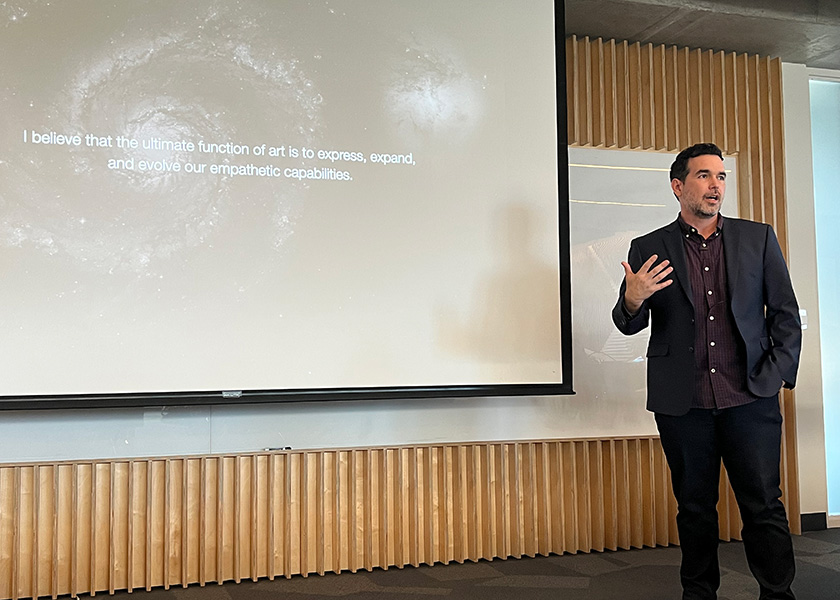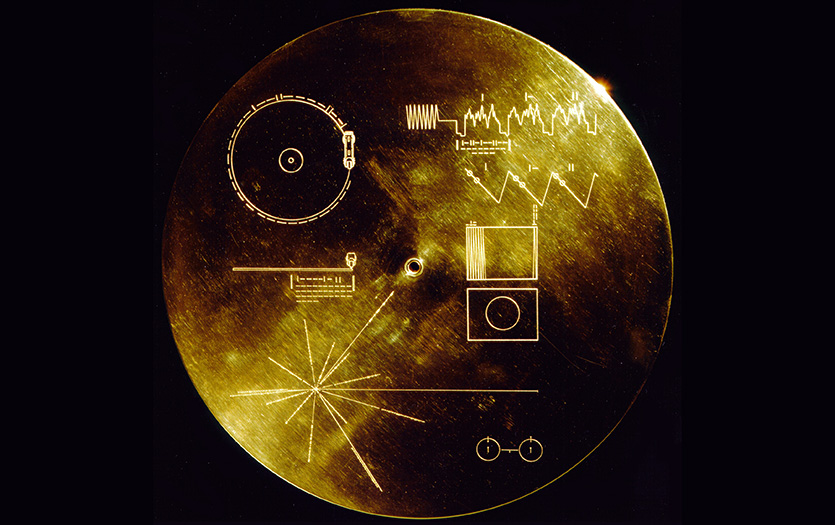Dario Robleto, Ann Druyan, and the Essence of Humanity
Robleto previewed his upcoming art exhibit during a Dean’s Seminar Series lecture
In 1977, NASA launched Voyager 1 and Voyager 2 to study the solar system and space outside of the sun’s reach. Affixed to the side of each craft was a golden audio-visual record with 90 minutes of storage and a billion-year shelf life, loaded with the sounds and images chosen to tell the story of Earth if the probes ever encountered intelligent life.
A member of the golden record team was Ann Druyan, whose specific job was to produce an audio portrait of the planet. Druyan, who was secretly engaged to Carl Sagan at the time, added sounds of crickets and wolves. She also asked Sagan a heavy and profound question: if she recorded her brain waves with an electroencephalogram (EEG) and electrocardiogram (EKG), could aliens eventually read her mind? Sagan encouraged her to try. So Druyan, hooked up to an EEG and EKG, began to think.
What Druyan thought about is the basis of the upcoming exhibition “The Heart’s Knowledge: Science and Empathy in the Art of Dario Robleto,” which will run from January 26 to July 9 at Northwestern’s Mary and Leigh Block Museum of Art. Robleto, the artist-at-large of Northwestern Engineering, produced 17 sculptures and prints for the show, plus his first two films.
During his November 3 Dean’s Seminar Series lecture, Robleto previewed the themes of the exhibition, which seeks to attune viewers to the material traces of life at scales ranging from the intimate to the universal.
“I want to engage with [Druyan’s] question in the most provocative way, which is, are we in our signals?” Robleto said. “And, can you play it back at a future date with all of the fidelity [Druyan] is hoping? Remember, the fidelity here is a question of the memory of humanity itself. So, there’s a lot riding on this [record] working, which it probably won’t. But [Druyan] tried.”
To tell Druyan’s story, Robleto thought about the scientific lineage that allowed her to record her brain waves. Robleto also wondered why Druyan chose to record her heart and brain, which opens philosophical questions about humans and their bodies.
“There’s an interesting story about where we think we are in our bodies that Ann was intuitively [telling] when she chose this,” Robleto said.
Robleto’s themes are discussed below.
Heartbeats
Robleto wondered when and where the first heart was recorded in history. He argued that is an important moment where Druyan’s story begins, because somebody somewhere had to figure out how to record a heart.
After years of research, Robleto found that Karl von Vierordt made the first mechanical, visual tracing of the human pulse in 1853. von Vierodt pulled a hair from his head, cut it down, and attached it to an air-pressure device. To actually record his heartbeat, von Vierodt gathered soot from a candle flame on a piece of paper, rigged it to a turning cylindrical drum, and was able to sync his own heart. The result was his hair carving the heartbeat in the candle-flame soot.
“This is just stunning to me that the first heart ever imaged would be recorded by soot from a candle flame in 1853 by a single hair,” Robleto said.

Scientists eventually tried to visualize emotions as wave forms, which Robleto believes Druyan was a part of. In the show, Robleto will exhibit a series of his lithographs depicting the first time the heart was recorded during the conditions of life. Using soot from a candle flame, Robleto replicated the first time a heart was recorded while smelling lavender, while eating chocolate, and while an umbilical cord was cut, among other examples.
“My goal was, could I tell a story of someone just living their life in all of its mundanity and all of its emotional power?” Robleto said.
Brainwaves
Like with the heart, Robleto tracked down history’s first brainwave recording. That was made by Italian physiologist Angelo Mosso, who retrofitted the technology developed for the heart for the brain.
To access the brain without cutting patients open, Mosso found people who survived significant skull injuries and had skin grow into the crevasses of their wounds, which made outer contours of the brain visible. One of them was Michele Bertino, a farmer and construction worker who had a brick fall on his head, leaving a major wound.
During one 1878 test in Turin, Italy, Mosso told Bertino not to move. But Mosso began the experiment just before noon, and Bertino heard the local church bells.
The church bells caused a reaction in the rudimentary testing device – similar to the one von Vierodt invented – and Mosso wondered why. He asked Bertino if he felt guilty about not saying his midday prayer, and Bertino said yes.
That reaction wasn’t a twitch or mistake, but a recording of Bertino feeling guilty.
“Not only does he birth brain imaging, but he’s the first to think that emotional states had a correlation in the blood flow to the brain,” Robleto said.
This is crucial to Druyan’s story, because Mosso showed that science could connect psychological states with physiological recordings that could be studied. To tell that story, Robleto tackled the earliest tests on dreams and emotions, converting the original waveforms to 3D forms. The 3D forms were made into bronze sculptures, laid into boxes that reimagine the original scientists conducting their field recordings.
Sound
Robleto’s show will also explore sound through the two immersive films. Along with colleagues, Robleto is trying to push a new field called sound archaeology. They argue that waves preserved in soot produced by the phonautograph – patented by Édouard-Léon Scott de Martinville in 1858 that predate playback technology invented by Thomas Edison – are actual sound recordings. Patrick Feaster, one of Robleto’s collaborators, was the first to play back the Scott de Martinville recording.
During his talk, Robleto played the sound that Scott de Martinville’s soot saved in 1860, 17 years before Edison invented the phonograph. The noise, while primitive, is a window into life back then, and illustrates how the vast majority of people in human history have no audible recordings. As Robleto pointed out, we know what Louis XVI looked like, but will never know what he sounded like.
Maybe, Robleto said, there is a workaround if we explore ways sounds were left behind. Though it’s highly unlikely Druyan’s recording will ever be heard, Robleto thinks it’s possible a different way will emerge in the future to play back the record.

“I’m arguing an artist can come up with solutions too, based on a different set of questions,” Robleto said. “In this case, where is the limit to empathy? That’s what I want to keep pushing on, inspired by Ann.”
Though remote, there is a possibility some lifeform somewhere will hear Druyan’s record. That would lead to more questions, with one in particular: who would that be? Druyan sent the disc with the hope we are not alone in the universe, which inspired Robleto to craft his own offering — a series of intricate pink sculptures composed of seashells and other materials. Gifts, like Druyan’s record, are a feature of altruistic and empathetic beings, Robleto said.
The color pink has another significance, and could mean an attempted connection with extra-terrestrials. Earth may have been pink once, and the aliens’ home could be pink, too. To forge that bond and show empathy, Robleto made sure his gift proposal was pink.
“The earliest color of life is pink. Because of the nature of the cytobacteria on the planet a billion years ago, it seems from the research that [pink] is the color that early life would have been making, rather than the green we’re all familiar with [from] photosynthesis,” Robleto said. “It likely means we had pink oceans because of that. Some image of Earth, with the pink hue, is heading out into the universe right now. If something were looking, based on the time discrepancies, they might think there’s life there and it’s pink.”
Connecting Art + Engineering
In 2019, Robleto was profiled by Northwestern Engineering and made the case for multidisciplinary collaboration to address critical social and ethical issues.